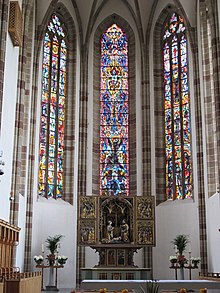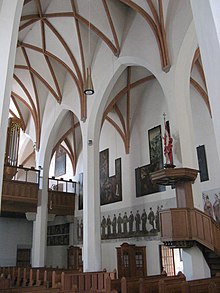Franciscan monastery of Bolzano
The Franciscan Monastery of Bozen ( Italian Convento dei Francescani ) with the Franciscan Church is located in Franziskanergasse 1 in the South Tyrolean capital Bozen . It is located in the Zentrum-Bozner Boden-Rentsch district . The church and monastery house valuable frescoes and other works of art.
history
According to an unconfirmed legend, St. Francis is said to have come to the market in Bolzano on a business trip with his father Pietro Bernardone, a cloth merchant. Little Francis said in the chapel of St. Ingenuin and St. Erhard , who is now part of the monastery complex, ministered at the mass and rang the bell there.
When in 1221 the first Friars Minor under Caesar von Speyer from the Order of St. Francis of Assisi moved to Germany via the Brenner Pass , they also passed Bozen on their way. They received permission to preach from the Bishop of Trento in his Bolzano castle. Apparently some of them stayed behind in Bolzano, because a Franciscan settlement on the city wall is mentioned in a document as early as 1237. The first Franciscan monastery was built around a Meierhof made available by the Bishop of Brixen outside the northern city wall with the Church of St. Ingenuin and St. Erhard. 1285 with the documented cimiterium sancti Francissci a separate cemetery and thus the right to burial are attested. After a fire destroyed the original Romanesque building in 1291, the monastery was rebuilt by 1322. In 1348 the associated Franciscan church could also be consecrated.
Because there was a decline in religious discipline at the beginning of the 16th century - especially the Franciscan ideal of poverty - a reform was carried out in the monastery in 1514. In the course of this, the Franciscans of the Observant Movement took over the Bolzano monastery. From 1580 it belonged to the newly founded Tyrolean Franciscan Province .
In 1780 Empress Maria Theresia initiated the establishment of today's Franciscan high school in Bolzano , with the management and teaching of the brothers of the monastery. Under the Bavarian rule, the monastery in Bozen was abolished in 1810 and parts of the convent were expelled from the country. It served briefly as a barracks until the Franciscans were able to move into the building again in 1813.
The Franciscan Church was destroyed by a bomb on March 29, 1944 and rebuilt after the war. In the first post-war years, the monastery, like several others in South Tyrol, which was the only German-speaking region not under the control of an occupying power, served as a hiding place for high-ranking National Socialists who were on the run. For example, Adolf Eichmann was housed in this monastery by the Sterzing pastor.
The church owes its current appearance externally (portico and facade) to the reconstruction after the Second World War and internally to a thorough renovation between 1990 and 1992. Today the Franciscans, who still live in parts of the monastery, devote themselves to pastoral care in Bolzano the monastery church and teaching at the grammar school. They have belonged to the Province of Austria of St. Leopold , based in Salzburg , since 2007 , after the South Tyrolean monasteries had previously been separated from the Tyrolean Franciscan Province following pressure from Italy after the First World War.
Franciscan Church
The tower of the church, unusual because of the building regulations of the mendicant orders, is 44 meters high and was completed in 1376. It has a pointed pyramid as a roof and eight sound windows with three-pass closures. The Gothic church itself consists of a three-aisled lay room and the polygonal long choir with wall services and vaulted ribs made of colored sandstone. According to an eyewitness report, the church tower was damaged in the great city fire of 1483 and the bells melted due to the heat of the fire.
Stained glass window
In the apse there are three large glass windows, modern work by the Innsbruck artist Josef Widmoser from 1954. The middle window shows the stigmatization of St. Francis. The church is also dedicated to this festival (September 17th). At the bottom of the left window you can see Francis giving his father money and clothes back, in the middle his appearance before Pope Innocent III. to have his community confirmed, and above the saints King Louis IX. of France and Elisabeth of Thuringia . The right window shows Francis between Christ and Mary above, his sermon on the bird in the middle and the death of the saint below.
Gothic carved altar
The late Gothic carved altar by Hans Klocker from 1500 has been placed in the choir . He originally stood in the Anna chapel, which was built parallel to the church and was donated by the Vintler family in Bolzano in 1373 . The shrine depicts the birth of Jesus, in the background the numerous entourage of the Three Wise Men are pushing up and the scene is framed by an arch made of tendrils and figures, the root of Jesse . When open, the carved images of the Annunciation and the Presentation of Jesus in the Temple as well as the circumcision of Jesus and the death of Mary can be seen on the two side wings . When closed, there are paintings with four farewell scenes of the apostles on the side wings. The predella shows the hl in the open state. Anna herself third , John the Baptist and the Apostle James, on the inner wings of the Predella Joachim and Anna ; when closed, the Annunciation of Mary, Anna the third and St. Clare of Assisi .
Lay room
The lay room, which was originally flat, was given a ribbed vault and octagonal pillars in 1450–54. Instead of the demolished Anna chapel, three baroque side chapels were added to the south side of the church in 1680. In the first side chapel is the Antonius Altar, donated by the Bozen Merchants' Guild in 1683, and in the third side chapel there are pictures of the Stations of the Cross by the Austrian painter Leo Sebastian Humer from 1954. Also on the south side is the large window of the Beatitudes by the Graz artist Hans Szyszkowitz from the Year 1994. At the front of the choir, the figure of a painful Mother of God from the 18th century and the figure of St. Joseph by the sculptor Franz Tavella from 1904 are placed on the left.
On the north side of the church is the Sebastian altar, the picture of which was created by Anton Psenner in 1826. To the left of the main entrance is the so-called “ Doctors' Frieze ” from shortly after 1500, on which originally 35, today only 21 learned members of the Franciscan order can be seen. Among them are the three Franciscan Popes Alexander V , Nicholas IV and Sixtus IV , as well as St. Bonaventure and John Duns Scotus , all not listed chronologically but hierarchically according to their church offices. On the eve of the Reformation , the fresco recorded the "social reputation of the intellectual monastic tradition". Above it hang the double doors of the former baroque organ by Andreas Butz (1618), which the Munich court painter Georg Fischer created in 1636.
Today's organ on the gallery comes from Johann Pirchner jun. from Steinach am Brenner (A) and was built in 1995. The organ has 44 registers , including 9 reeds, three manuals and a pedal ; it was mainly inspired by the baroque style ( Gottfried Silbermann , Freiberg), but due to the rich tongues it was also suitable for romantic music, especially French romanticism. The principal 16 'of the main work is in the prospectus , next to the console is the swellable substructure, behind the middle pedal tower is the swellable upper work.
Cloister
Probably before the completion of the choir in 1348, the cloister was added to the north of the church. Three pillars connected by deep cloverleaf arches follow three pillars, in the southern wing four pillars. The vaulting of the cloister took place before 1484, due to the support of Archduke Sigmund the rich in coins . His coats of arms can be seen as keystones in the east wing. Of particular importance are frescoes from Giotto's school in the south wing from around 1320 to 1330. They depict a crucifixion and Christ's descent from the cross. Another fresco around 1360 shows a Franciscan in a medallion who recommends two laypeople to the Blessed Mother. A frieze with the heads of prophets is also from this period. Also worth mentioning is an Adoration of the Kings by the Bolzano painter Ludwig Pfendter from 1607 and a 90 cm high relief of the Man of Sorrows from the 2nd half of the 14th century. The vaulting of the cloister partially damaged the original painting, so that around 1490 to 1520 the east wing was redesigned al secco . Only in the 1970s were 30 medallions with hermits uncovered in the north wing (1609). In the lunettes, 13 of the original 25 oil paintings on the life of St. Francis by Hilarius Auffenbacher (1711–19) can still be seen, one picture is by Lukas Plazer.
On the east side of the cloister within the enclosure are the Erhard chapel with frescoes from the 14th and 17th centuries and the Johannes chapel. To the west of the cloister and church is a churchyard with the tombstone of the exiled Prince Petre Şchiopul (Peter the Lame, 1574–1577) of Moldova , who was expelled by the Turks and buried in this church in 1594.
literature
- Norbert Karl Weis: The Franciscan monastery in Bozen in its historical development . Brixen 1946
- Sven Mieth: The Franciscan Monastery in Bolzano, history - building history - art 1221-1514 . Bolzano: Athesia 1998. ISBN 978-8870149807
- Willibald Hopfgartner: The Franciscan monastery in Bozen . Regensburg: Schnell & Steiner 2009. ISBN 978-3-7954-6800-2
Web links
- Entry in the monument browser on the website of the South Tyrolean Monuments Office
- Franciscan monastery of Bolzano
- Franciscan high school in Bolzano
- Franciscans in Austria and South Tyrol
Individual evidence
- ^ Hannes Obermair : Bozen Süd - Bolzano Nord. Written form and documentary tradition of the city of Bozen up to 1500 . tape 1 . City of Bozen, Bozen 2005, ISBN 88-901870-0-X , p. 105 f., nos. 64-65 .
- ^ Gerhard Mumelter : Nazi escape route South Tyrol. Review of Gerald Steinacher's book Nazis on the run. How war criminals escaped overseas via Italy. In: Der Standard , January 3, 2009, p. Album A 5
- ^ Hannes Obermair: Bozen Süd - Bolzano Nord. Written form and documentary tradition of the city of Bozen up to 1500 . tape 2 . City of Bozen, Bozen 2008, ISBN 978-88-901870-1-8 , p. 182, no.1207 .
- ↑ Hannes Obermair: Early knowledge. Looking for pre-modern forms of knowledge in Bolzano and Tyrol . In: Hans Karl Peterlini (ed.): Universitas Est I . Bozen: Raetia 2008. ISBN 978-88-7283-316-2 , pp. 35-87, reference pp. 78-79.
Coordinates: 46 ° 30 ′ 2.9 ″ N , 11 ° 21 ′ 14.7 ″ E




